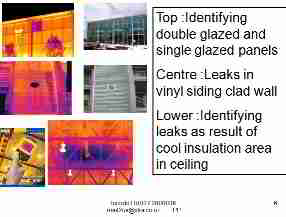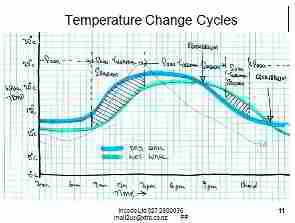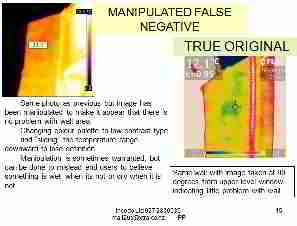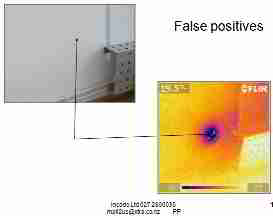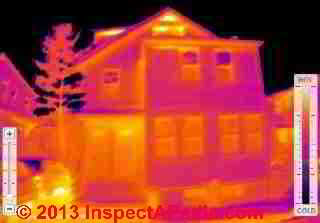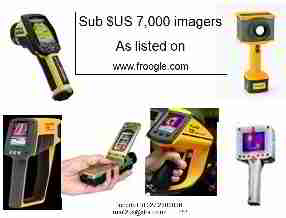 Thermography 101: Thermal Imaging in Buildings
Thermography 101: Thermal Imaging in Buildings
Types, uses, & where to buy InfraRed or Thermal Scanners & Cameras
- POST a QUESTION or COMMENT about the use of thermography & thermal imaging for finding building leaks, rot, insect damage, heat loss, mold
Guide to effective use of thermography: this article describes the use of thermography, infra red imagers or scanners for observing building component or temperature variations as a component of building inspection, testing or surveys as part of an energy audit, house doctoring, heat loss, moisture screening, or screening for hidden building damage or mold contamination.
We describe how thermal imaging is used in building surveys and we list sources of error in conclusions some may draw from examination of thermal images or data. We include sources of thermal imaging equipment, thermal scanners, and thermography education and training. Page top image of thermal scan results provided courtesy of Paul Probett, Incodo Ltd., a New Zealand Forensic Building Specialist.
InspectAPedia tolerates no conflicts of interest. We have no relationship with advertisers, products, or services discussed at this website.
- Daniel Friedman, Publisher/Editor/Author - See WHO ARE WE?
Thermography 101: Thermography & Thermal Images Used in Building Surveys
 Paul Probett, Incodo Forensic Building Specialists [1]
Paul Probett, Incodo Forensic Building Specialists [1]
This article is adapted with permission from Thermal Imaging and Building Surveying / Inspection, a 2008 presentation by Paul Probett. [2]
Article Contents
- THERMAL IMAGING, THERMOGRAPHY
- SOURCES of ERROR in Thermal Imaging
- KEY OBSERVATION FACTORS in Moisture Detection (or heat loss detection)
- IR CAMERAS, TOOLS, SUPPLIERS - Sources for Infra Red / Thermal Scanners, Cameras, & Thermography Equipment
- THERMOGRAPHY CLASSES in use of thermographic equipment & thermal imaging & FLIR for building surveys
- THERMAL IMAGING MOLD SCANS - separate article
Thermal images and IR have been widely used with some success at spotting areas of heat loss in buildings and these tools have a longer history of use in examining overheated electrical connections, motors, etc.
Examples of Using IR Infrared Scanning Thermography Equipment for Building Surveys
We have made regular use of small handheld IR or thermal scanner equipment in building inspection surveys for nearly twenty years. The most common uses we've made of the equipment are described here.
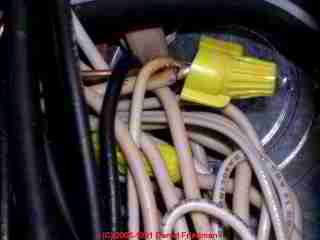
See ALUMINUM WIRING HAZARDS & REPAIRS for an example of aluminum wiring overheating shown in the two photographs at left and just above. These photos show an improper aluminum-to-copper pigtail splice which is overheating, and an infra-red photo of the same connection, from a more distant view (courtesy of G. Cohen).
- Building Heat Loss:
Surveying buildings for variations in temperature, indicating areas of heat loss: air bypass leaks, missing insulation.
In addition to spotting specific "cold spots", if there is a significant temperature difference between indoors and outside, thermography can quickly identify and compare temperatures on interior partitions with exterior walls. - Building Moisture Traps, Leaks:
Surveying buildings for evidence of recent leaks, wet insulation in building cavities.
Be careful: an old leak into a building cavity may have completely dried out, producing no IR detectable information, but problematic mold, rot, or insect damage could be present. Visual evidence of building leak history and a recording of building details likely to have led to leaks or water entry are important. - Electrical overheating:
A number of home inspectors have successfully used IR and thermography to identify overheating electrical components at electrical panels, electrical switches or receptacles, at wiring serving electric heating baseboards, and where aluminum branch circuit wiring is installed.
Overheating electric motors, compressors, and even blower fan bearings can be observed using these methods as well, provided that you have a baseline of normal temperatures. - Tracing heating elements:
Such as the location of radiant heat tubing in floors or ceilings and finding leaks in those systems.
Are Thermal Images Useful in Spotting Areas of Extra Risk of Structural Rot Damage or Hidden Mold in Buildings?
 OPINION: Thermal images and IR have been widely used with some success at spotting areas of heat loss in buildings and these tools have a longer history of use in examining overheated electrical connections, motors, etc. But for finding hidden mold, thermography is a risky proposition. [Ed. DF]
OPINION: Thermal images and IR have been widely used with some success at spotting areas of heat loss in buildings and these tools have a longer history of use in examining overheated electrical connections, motors, etc. But for finding hidden mold, thermography is a risky proposition. [Ed. DF]
Image at left, courtesy Paul Probett, Incodo [1]
Watch out: in the hands of the untrained or unscrupulous, these and other tools can wreak havoc or harm to consumers.
The most egregious instrument snafu I've come across [DF] recently was a Hudson Valley New York "mold remediator" using an IR camera to tell his clients where the hidden mold is located in their home - it was a modern version of the guy with the light meter who sold people replacement windows by showing clients where their heat loss was occurring - wherever there was light.
I did find areas of basement water entry and moldy insulation - in an area not addressed by the New York mold-thermographer. Details about using thermal imaging to look for hidden mold are
at THERMAL IMAGING MOLD SCANS.
Also see FIBERGLASS INSULATION MOLD
A different case - a thermal imaging report with almost no useful data, is discussed
at ROOF VENTILATION IMPROVEMENTS.
Paul Probett adds: We had major problems with people buying thermal imagers, using ex-military units and making ridiculous claims. In 2008, I gave a power-point presentation [25] to a conference explaining how IR results can be fudged and I described the limitations of thermal imagers. (Our staff had been through the Infraspection Institute USA on-line course to level 2 the year before).
Mr. Probett's 2008 power point presentation on using thermography in building damage or mold surveys is adapted and expanded in the article text that follows.
Consumer Tip For Hiring a Building Surveyor or Mold Inspector
The person who screens your building for mold contamination or other possibly costly repairs and who defines the initial scope of work to be performed should have no business nor any other relationship with the contractor who will ultimately perform the work.
Reliance on "tests" for hidden mold without an expert visual inspection will not give the most reliable results and some building mold screening test methods are simply invalid.
See MOLD INFORMATION CENTER for extensive advice on building mold contamination.
See FIND MOLD, ESSENTIAL STEPS.
See MOLD / ENVIRONMENTAL EXPERT, HIRE ? for help in determining if hiring an expert is probably justified.
Also see MOLD KILLING GUIDE for more typical mold cleanup snafus.
Sources of Error in Thermal Imaging and IR Temperature Measurements
 Paul Probett, Incodo Forensic Building Specialists [1][2]
Paul Probett, Incodo Forensic Building Specialists [1][2]
In our opinion, thermal imaging is a very useful tool for building surveys, but building inspection reports that rely primarily or only on thermal imaging tend to be flawed.
- Surface readings:
Thermal imagers give only surface temperatures of materials. Imagers infer or suggest or hint at surface conditions, they do not prove conditions.
[E.g. the mold remediator argued that cool temperatures equaled moisture in the building equaled mold contamination - a series of assertions that was both false and fraudulent - DF]
Images at left, courtesy Paul Probett, Incodo
- Dry areas:
Thermal imagers will miss areas that have dried, and won't indicate mold. [Moisture meters have this same limitation - DF] - Reflected heat:
Thermal imagers can give confusing results when a surface reflects heat from an adjacent source such as windows, mirrors, shiny materials
[E.g. for an accurate measurement using our Exergen device, not an imager but a surface temperature measurement device, the manufacturer provides a flat black crayon used to make a flat black spot on the surface to be measured - DF]
- Wind effects:
Strong winds washing the building exterior artificially heat or cool the building - Emissivity:
Thermal imaging for moisture detection is based on measuring the radiated heat of building components such as walls, ceilings etc. This is very different from reflected heat. - Angle of reflectance:
Angles off of 90 degrees cause a surface to become more reflective - Surface moisture:
Condensation on surfaces will cause the imager to pick up the temperature of what is reflected in the glossy coating
- Dirt and mold:
Similarly, high levels of dirt or profuse mold growth affect the getting of meaningful images as they change the reflectance - Rain:
Recent rainfall acts to cool surfaces to an even level, making differentiation of wet or dry areas difficult - Distance:
From the surface being measured: low-end instruments have limited magnification; more distant measurements of surfaces are more difficult and less accurate - Focus:
Focusing levels are relatively low; failure to make proper settings can hide small suspect areas
- Temperature changes:
Having sufficient temperature changes within a short time period and of sufficient variation are critical to obtaining meaningful results; temperature fluctuations during the day are affected by changes in wind speed, air temperature, cloud cover, humidity, sunlight direction - all sources of error in making comparative measurements
Key Observation Factors in Moisture Detection (or heat loss detection) using Thermal Imaging
- General Shape:
elongated triangles, fuzzy edged vertical strips or teardrop shapes on vertical surfaces and ink blot shapes on ceilings - irregularity is common - Intensity:
the degree of temperature contrast compared with adjacent areas of similar material - Edge definition:
moisture patterns tend to have wavy edges whereas air leaks tend to be more "feathered" - somewhat like cirrus clouds - Position in building:
often leaks are detected in high risk areas dependent on construction design and methods - Patterns:
regular patterns often show up as cool areas worthy of further investigation, but when patterns are regular what can appear as probable wet areas may only be poorly fitted insulation

False positive thermal images are illustrated in Probett's slide shown at left.
At top right is the digital image of the building exterior wall.
At lower left is a thermal image that might be indicating a water leak or moisture collected inside the wall at its top section.
At lower right the image has been digitally manipulated to dramatize the apparent leak.
A thermal image can be manipulated by accident of how the image was collected (at an angle or with improper camera adjustments) or deliberately by an unscrupulous operator.
In these images, Mr. Probett illustrates how easily a color image from a thermal imaging camera might be manipulated - in this case changing the color palette and contrast and temperature range to lose definition.
Examples of a false positive thermal image reading include the thermal images at left.
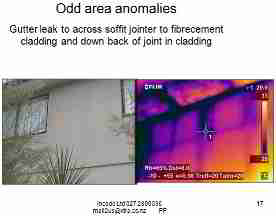
The thermal image shown at left illustrates wet or damp areas and concomitant temperature differences noted by the IR camera.
In this case the surveyor was reporting on a gutter leak that sent water across the soffit and behind the fiber-cement cladding on the building wall.
Example Thermal Imaging Report
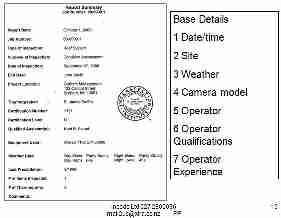 The image at left illustrates a page from a typical thermal scan thermography report issued by Incodo.
The image at left illustrates a page from a typical thermal scan thermography report issued by Incodo.
[Click to enlarge this or any images in this article]
Data Recorded by Thermal Imaging Camera
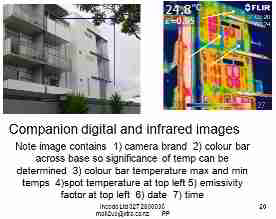 The thermal image at upper right in the Incodo slide illustrates important data recorded on FLIR thermal images:
The thermal image at upper right in the Incodo slide illustrates important data recorded on FLIR thermal images:
- The IR camera brand
- A reference color bar across the image base showing the maximum and minimum temperature differences across the entire image (and thus across the scanned surface)
- The emissivity factor (0.95 in this case) and ambient temperature
- The date and time that the thermal image was taken
Limitations of Thermal Imaging for Building Surveys
- Thermal imagers currently available are adequate and suitable for moisture detection work - for active leaks.
- Thermal imagers do not show moisture, decay (wood rot), wet insulation, nor mold.
They only indicate temperature differences. However thermal imagers can infer an increased probability of leaks provided that the operator understands his/her equipment, has an understanding of thermography to a reasonable level, and understands how the areas being considered have been built, the materials used, and other clues or data that give or suggest the leak or moisture history of the building. - Thermal imaging equipment's prime use in detecting moisture problems is to rapidly scan large areas or areas that are difficult to access. The scan can highlight areas of possible trouble where further investigation might be appropriate.
Watch out: old leaks that have caused rot, insect damage, or mold contamination will not show up in thermal imaging if moisture from the leak is no longer present. - Thermal imaging is particularly useful in determining dew point problems in building cavities as well as air leakage and insulation issues, as we further detail.
at HOUSE DOCTOR, how-to be - Thermal imaging is widely used to detect overheating electrical wiring, aluminum wiring active hazards, overheated motors, etc.
See ALUMINUM WIRING HAZARDS & REPAIRS for an example.

The thermal image at the upper right corner of Probett's slide illustrates a temperature difference that could point to a possible leak into a roof eave or soffit.
At lower left in the slide you can see a moisture meter reading being taken in the suspect area.
The Quality of Thermal Imaging Results Depends on Probett's 5 "Es"
- Expertise:
(which is not the same as experience), including- Expertise in thermography generally, including some formal, internationally recognized training. ASTM type qualifications range from level 1 - 3.
Our thermal image of a building shown at left is an example of what in our OPINION was a worthless "thermal imaging report" provided by a reader and discussed
at ROOF VENTILATION IMPROVEMENTS.
[Click to enlarge any image] - Camera-specific training
- Building-related expertise, building science, understanding how types of construction, construction details, construction materials, and other historic or visual clues predict hidden building problems
- Expertise in thermography generally, including some formal, internationally recognized training. ASTM type qualifications range from level 1 - 3.
- Experience:
this takes time and hands-on use of the camera, applying the training in 1. above. - Equipment:
The quality of the thermography or IR equipment used has a significant bearing on the quality of results that can be obtained. For moisture detection work, most authorities would suggest a sensitivity of at least 0.13K is required and preferably 0.10K or better - Extra Equipment:
By using other quality, non-destructive equipment such as moisture meters having a minimum penetration depth of 50mm there is an increased likelihood of actual moisture being detected and the number of false positives will be reduced. Mixing other NDT equipment such as capacitance, dielectric constant and microwave devices will increase the reliability of results - Ethics:
Some have a concern that there is a "cowboy" element operating in the thermal imaging / moisture detection industry. This is reflected in large variations in basic charge-out rates coupled with low quality reports and outlandish claims as to equipment quality, cost, availability, etc. For example:
"allows ... to effectively see right through walls of a house"
"enables ... to pinpoint a problem when there is no other means available"
"imaging for those who don't want often inaccurate cutting of holes" *
*Quotes from New Zealand web pages, September 2007
Reports can be prepared to give the owner what they want. For example, "proof" that their home doesn't leak. - A Sixth "E" - Economics:
While not related to professional operations by a thermographer, the charges relating to services offered vary widely and may not relate to any of the "Es" above. In fact, in the U.S., Friedman reports [above] at least one mold remediation company who includes IR scans and thermographic work "free" as part of a building survey intended to sell his services.
Where to Buy IR Scanners, Cameras, Thermography Equipment
Thermal Scanner Attachments for Smartphones
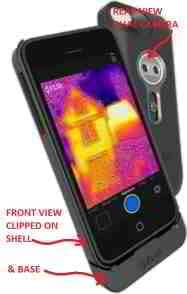 FLIR One™ is an iPhone™ attached thermal imaging camera (as well as a second imaging camera) that clips to the back of an iPhone™. One source gave a price of $350. U.S. vs. around $1000.+ U.S. for the FLIR "professional imagers".
FLIR One™ is an iPhone™ attached thermal imaging camera (as well as a second imaging camera) that clips to the back of an iPhone™. One source gave a price of $350. U.S. vs. around $1000.+ U.S. for the FLIR "professional imagers".
According to the company, currently (2014), one can purchase the FLIR ONE only in the U.S., though the company has offices and distributors world-wide.
The smartphone-attached thermal camera from FLIR thermal camera can detect temperature differences of about one-tenth of a Fahrenheit degree, and the temperature read-out is accurate to within 2°F.
The FLIR ONE™ iPhone-attached thermal imager is shown at left. An Android FLIR One™ model is also available.
The image at left, adapted from FLIR One™ literature, shows the thermal imaging camera as a shell that snaps around an iPhone and takes its power from the phone's base connector.
This thermal imager incorporates two cameras (thus those two small dark openings in the round silver disc on the imager's surface at upper right in our illustration): a thermal image lens (80x60 pixels) and a conventional imaging lens (640 x 480 pixels) allowing capture of conventional and thermal images of the same scene.
Other SmartPhone-connected Thermal Imaging Cameras and applications are available.
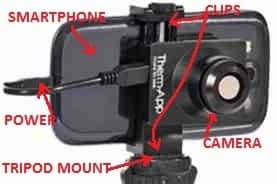 A thermal imaging camera attachment that can work on Android smartphones is available: the Therm-App™ from Opgal (opgal.com), a producer of infrared thermal imaging and near IR illumination products.
A thermal imaging camera attachment that can work on Android smartphones is available: the Therm-App™ from Opgal (opgal.com), a producer of infrared thermal imaging and near IR illumination products.
The Therm-App™ smartphone-attached thermal imager is shown at left.
The Therm-App™ IR camera is not as flat an add-on as the iPhone-fitted clip-on FLIR One™ but the Therm-App™ has a significantly higher-resolution lens ( 384 x 288 pixels vs. 80 x 60 pixels for the FLIR One™ thermal imager), offering sharper images that may be important if the images are to be enlarged or used in larger format reports.
Cost for the Therm-App™ thermal imager is about $1000. U.S. Optional lenses and other attachments are available as well.
Using a clip-on such as the Therm-App™ hand it means that Android smartphone users don't have to buy an iPhone - which could be far more than the cost of the phone as one will surely also subscribe the iPhone to a phone service. This device will attach to many smartphones.
At the company contact links below, we give the power, smartphone clip size range and other specifications for the Therm-App™ thermal imager. See http://therm-app.com/
Infra Red Inspection Equipment, temperature, heat loss, active leak detection, moisture investigations - Equipment Suppliers
- AGA Infrared Systems, 550 County Ave., Seacaucus NJ 08094.
Here is a GENERAL PRODUCT BROCHURE FROM AGA [PDF] (minor edits),
History: the AGA Thermovision 750 was produced in the 1970's and was the first individually portable thermography system to reach the market.
Here is the AGA THERMOVISION 750 OPERATING MANUAL [PDF] from AGA. A used AGA Agema Thermovision 880 800 Infrared Camera Sys FLIR might be purchased typically (2010) for around $2000.
Warning: looking for information about AGA will trip up readers whose web searches will find the American Gas Association AGA. AGA Infrared Systems AB [ca 1981] was a member of the Pharos Group, manufacturer of a complete range of thermal measurement systems, with subsidiaries worldwide. - Headquarters: AGA Infrared Systems AB, S-182 11 Danderyd, Sweden
- Canada: AGAtronics Ltd., 5230 South Service Rd. Suite 125, Burlington Ontario L7L 5K2
- United States: AGA Corporation, PO Box 721, 60 Chapin Rd., Pine Brook NJ 07058
- West Germany: AGA Optronik GmbH, Zimmersmuthlenweg 40, D-6370, Oberursel/T
- EXERGEN CORPORATION, portable infra red scanners, 400 Pleasant St. Watertown, MA 02472, 1-800-422-3006 617-923-9900 Fax : 617-923-9911
- FLIR Thermography - produces IR cameras and scanners including the FLIR ONE™ smartphone-attached thermal scanning cameras for iPhone and for Android phones (coming 2014). FLIR has offices worldwide, for which we give several contact offices below. Website: http://flir.com/flirone/index.cfm, Technical support: HELPLINE 1-844-283-5471 (US) 1-805-392-3775 (International)
- FLIR Asia Pacific: FLIR Thermography Support & contact information:FLIR Systems Co., Ltd. Asia Pacific Head Office, Hong Kong Tel: +852 2792 8955
- FLIR Canada: FLIR Thermography Support & contact information:FLIR Systems Ltd., Canada's Main Office, Burlington, ON Tel: 1-800-613
- FLIR Europe: FLIR Systems International Main Office, Sweden Tel: +46 (0)8 753 25 00
- FLIR Commercial Systems FLIR Systems Trading Belgium BVBA Luxemburgstraat 2 2321 Meer Belgium Tel. : +32 (0) 3665 5100 Fax : +32 (0) 3303 5624 e-mail: flir@flir.com
- FLIR Systems GmbH Berner Strasse 81 D-60437 Frankfurt am Main Germany Tel.: +49 (0)69 95 00 900 Fax: +49 (0)69 95 00 9040 e-mail: flir@flir.com
- FLIR Systems Italy Via Luciano Manara, 2 I-20812 Limbiate (MB) Italy Tel.: +39 (0)2 99 45 10 01 Fax: +39 (0)2 99 69 24 08 e-mail: flir@flir.com
- FLIR Systems UK 2 Kings Hill Avenue - Kings Hill West Malling Kent ME19 4AQ United Kingdom Tel.: +44 (0)1732 220 011 Fax: +44 (0)1732 843 707 e-mail: flir@flir.com
- FLIR Commercial Systems Avenida de Bruselas, 15- 3º 28108 Alcobendas (Madrid) Spain Tel. : +34 91 573 48 27 Fax.: +34 91 662 97 48 e-mail: flir@flir.com
- FLIR Latin America: FLIR Thermography Support & contact information:FLIR Systems Latin America, Sorocaba, Brazil, Tel: +55 15 3238 8075
- FLIR Systems Russia 6 bld.1, 1st Kozjevnichesky lane 115114 Moscow Russia Tel.: + 7 495 669 70 72 Fax: + 7 495 909 93 02 e-mail: flir@flir.com
- FLIR United States: FLIR Thermography Support & contact information: FLIR Systems, America's Main Office, USA
Boston, MA Tel: 1-800-GO-INFRA (464-6372) or 1-978-901-8000 Website: http://www.flir.com/thermography/americas/us/
FLIR offers this comment on use of infrared for building diagnostics:
Quoting:
Thermal Cameras for Building Diagnostics: the building sector offers the largest single potential for improving energy efficiency. Infrared thermography is the easiest and quickest method to detect energy waste, moisture and electrical issues in buildings. An infrared camera shows exactly where the problems are and helps focus the inspectors' attention allowing him or her to properly diagnose areas with energy loss.

- Opgal Thermal Imaging, Website: http://www.opgal.com/ or for the Opgal Therm-App™ Smartphone or Android phone thermal imager attachment, see http://therm-app.com/# - the Therm-App smartphone camera attachment is shown at left.
Therm-App™ Technical specifications (partial): Resolution: 384 x 288 pixels, Spectrum: LWIR 7.5-14um, Lens options: 6.8mm Lens (55 x 41 ) / 19mm Lens (19 x 14), Power supply: 5V over USB cable attached to the smartphone, Smartphone clip size range: Clip-on for smartphone (5.8-10cm span), Smartphone Operating System: Android 4.1 and up, Thermography mode: Color temperature mapping: 5°C – 90°C, Available colors: Rainbow, Iron, Grayscale. Enhanced vision mode: High-resolution thermal imagery (grayscale night vision) NETD <0.07 degrees C - Inframetrics Inc., hand held thermal scanners, 25 Wiggins Ave., Bedford Mass, also available from Hughes Aircraft, El Segundo, CA.
- IMAGING SYSTEMS INSPECTION EQUIPMENT Inc. - 323 Andover Street - Wilmington, MA 01887 [focused on electronics and semiconductor placement systems, not building heat loss/IR thermography for general use]
- ISG, X380 INFRARED SCANNER OPERATING MANUAL [PDF] (2013) ISG Infrasys USA 305 Petty Road, Ste. B Lawrenceville Georgia 30043 USA - ISG Infrasys UK Unit 14 Repton Court Basildon Essex SS13 1LN United Kingdom
- OPUS INSTRUMENTS Beacon House, Nuffield Road, Cambridge, CB4 1TF United Kingdom, Tel: +44-0-1223-727102, email: sales@opusinstruments.com, Website: www.opusinstruments.com
The company produces Osiris infrared reflectography cameras that capture a high resolution 16 megapixel image with object resolution down to 0.05mm (0.002 inches).
Special thanks to Dusseldorf art conservator Ulrik Runeberg (See PAINT FAILURE, DIAGNOSIS, CURE, PREVENTION) for this citation.
Quoting:
Working with the National Gallery (London), Opus has developed the groundbreaking Osiris camera specifically designed for high-resolution infrared reflectography. Osiris is the first infrared imaging system to provide high-resolution, high-speed images in a small lightweight camera.
Where to Find Thermography & FLIR Classes & Education
- INFRARED TRAINING CENTER,
9 Townsend West, Nashua, NH 03063 USA, Tel: 1-866-872-4647,
http://www.InfraredTraining.com
Quoting:
Specialized instruction in building diagnostics, roofing, electrical, mechanical, research and science, and optical gas imaging
Online courses that cover the basics of thermal camera operation and reporting software
LEVEL I THERMOGRAPHY CLASS: Baltimore, MD - 03/24 - 03/27/2014
The Level I Infrared Thermography training course is geared to the new infrared camera user and focuses on the camera’s use for a variety of condition monitoring/predictive maintenance applications. Attendees who complete the course receive a Level I Infrared Thermography certification and a wallet ID card.
OPTICAL GAS IMAGING CLASS: Harrisburg, PA - 02/11 - 02/13/2014
The Optical Gas Imaging training course teaches students which gases can be found with FLIR optical gas imaging cameras and leak size limitations. Attendees who complete all training course requirements and a field assignment will receive an Optical Gas Imaging Thermographer certification.
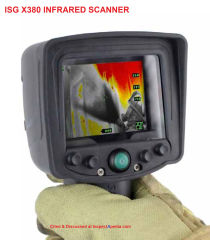
- INSTITUTE OF INFRARED THERMOGRAPHY, (the company's website does not provide their mailing address nor telephone number). info@infraredinstitute.com Quoting from the Institute of Infrared Thermography's self-description:
The Institute of Infrared Thermography (IRT) is an organization dedicated to providing Infrared educational programs, seminars, consulting services, program development and support, as well as, research and development to individuals and companies worldwide.
The original training organization, the Academy of Infrared Thermography began operation in 1984 in Kamloops BC Canada. The Academy was the largest independent infrared training organization in the world. Today, the original owner, Mr. Ron Newport provides global infrared thermography training under a newly structured organization: The Institute of Infrared Thermography.
The head office remains in Canada but there are now branch offices in the UK, Sweden, the Netherlands, Singapore, China, as well as trainers in 4 other countries.
IRT provides training in infrared thermography as it applies to the electrical industry, petrochemical, automotive, plastics, steel, electronics, energy conservation and savings, building energy conservation and building audits, building facades, roof thermography, water leak detection, security, medical and many other applications.
...
Continue reading at THERMAL TRACKING BRIDGING GHOSTING or select a topic from the closely related articles below, or see the complete ARTICLE INDEX.
Or see these
Recommended Articles
- AIR LEAK DETECTION TOOLS
- ALUMINUM WIRING HAZARDS & REPAIRS
- ATTIC MOISTURE or MOLD INSPECTION
- BASEMENT HEAT LOSS DETECTION
- CATHEDRAL CEILING INSULATION
- CONVECTIVE LOOPS & THERMAL BYPASS LEAKS
- DUCT CONNECTIONS, LEAKY
- FORENSIC INVESTIGATION of BUILDINGS
- HEAT LOSS DETECTION TOOLS
- HEAT LOSS INDICATORS
- HOUSE DOCTOR, how-to be
- ROOF ICE DAM LEAKS
- INSULATION AIR & HEAT LEAKS
- RADIANT SLAB TUBING LEAKS - track down using thermal scans
- ROOF ICE DAM LEAKS
- TEMPERATURE MEASURING INSTRUMENTS
- THERMAL IMAGING MOLD SCANS - warning: this is not a reliable nor recommended procedure
- THERMAL TRACKING BRIDGING GHOSTING
- THERMOGRAPHY IR Infra Red & THERMAL SCANNERS where we've report other sources of thermal imaging information.
Suggested citation for this web page
THERMAL IMAGING, THERMOGRAPHY at InspectApedia.com - online encyclopedia of building & environmental inspection, testing, diagnosis, repair, & problem prevention advice.
Or see this
INDEX to RELATED ARTICLES: ARTICLE INDEX to BUILDING ENERGY SAVINGS
Or use the SEARCH BOX found below to Ask a Question or Search InspectApedia
Ask a Question or Search InspectApedia
Try the search box just below, or if you prefer, post a question or comment in the Comments box below and we will respond promptly.
Search the InspectApedia website
Note: appearance of your Comment below may be delayed: if your comment contains an image, photograph, web link, or text that looks to the software as if it might be a web link, your posting will appear after it has been approved by a moderator. Apologies for the delay.
Only one image can be added per comment but you can post as many comments, and therefore images, as you like.
You will not receive a notification when a response to your question has been posted.
Please bookmark this page to make it easy for you to check back for our response.
IF above you see "Comment Form is loading comments..." then COMMENT BOX - countable.ca / bawkbox.com IS NOT WORKING.
In any case you are welcome to send an email directly to us at InspectApedia.com at editor@inspectApedia.com
We'll reply to you directly. Please help us help you by noting, in your email, the URL of the InspectApedia page where you wanted to comment.
Citations & References
In addition to any citations in the article above, a full list is available on request.
- [1] Paul Probett, Clinton Craig, Blake Probett, "An Introduction to Micro-Drilling Technology for N. Z. Structural Timber Assessment", Incodo Ltd, 4/511 Cameron Rd, Tauranga NZ, article adapted by InspectAPedia with permission, August 2012. Contact the authors by Email: Paul Probett, mail2us@incodo.co.nz , Tel: 027 28 000 36 (Mobile) Website: https://www.incodo.co.nz/ [Copy of this article on file as Microdrilling_Assessment_Incodo.pdf]
Quoting from the Incodo website the company describes its services:
- Incodo Forensic Building Pathology:
The Forensic Building Pathology division provides evidence in report form to government agencies, consultancy firms, lawyers and others, when truly independent analysis based on comprehensive testing is required. Incodo arguably has the largest, most up-to-date and comprehensive range of building investigation equipment available and has developed unique methodologies particularly in the field of non-destructive testing for leaking structures. - Incodo In situ Timber Assessment:
The in-situ Timber Assessment division provides a service whereby technicians use state-of-the-art timber resistance drill technology to profile variations in timber density associated with timber decay.
The work is done on site and the results are instant.
This technology is objective and evidential in nature and provides assessment as to whether wood is significantly decayed, suspect or suitable for retention. The technology has particular application in locating and assessing hidden decay.
- Incodo Forensic Building Pathology:
- [2] Paul Probett, Incodo, Ltd., "Thermal Imaging and Building Surveying / Inspection" 2008, Incodo Ltd, 4/511 Cameron Rd, Tauranga NZ, article adapted by InspectAPedia with permission, August 2012. Contact the authors by Email: Paul Probett, mail2us@incodo.co.nz , Tel: 027 28 000 36 (Mobile) Website: https://www.incodo.co.nz/ [Copy of this article on file as Thermal Imaging NDT Presentation 2008.ppt ]
Mr. Probett NZCB, MNZIBS, MBOINZ, AAMINZ, AssMLEADER, ANZLS, is a member of the Claddings Institute, The Society for Construction Law, Adjudicators Association, Australasian Sustainability Assessors Association, ExBranz Accredited Adviser, Insfraspection Institute Thermograph er, WSG Assessor, DBH Determinations Expert, ECCA HERS Assessor. Contact information for his firm, Incodo, is given just above. Mr. Probett adds:
Just a little point – two of us have completed James Seffin’s Infraspection Institute Thermography Course to level 2 on line – but have not sat the exams ( little difficult to arrange from down here ) - [3] Steven Bliss served as editorial director and co-publisher of The Journal of Light Construction for 16 years and previously as building technology editor for Progressive Builder and Solar Age magazines. He worked in the building trades as a carpenter and design/build contractor for more than ten years and holds a masters degree from the Harvard Graduate School of Education. Excerpts from his recent book, Best Practices Guide to Residential Construction, Wiley (November 18, 2005) ISBN-10: 0471648361, ISBN-13: 978-0471648369, appear throughout this website, with permission and courtesy of Wiley & Sons. Best Practices Guide is available from the publisher, J. Wiley & Sons, and also at Amazon.com .
- [5] "A Brief Guide to Mold, Moisture, and Your Home", U.S. Environmental Protection Agency US EPA - includes basic advice for building owners, occupants, and mold cleanup operations. See http://www.epa.gov/mold/moldguide.htm
- [6] US EPA - Mold Remediation in Schools and Commercial Building [ copy on file as /sickhouse/EPA_Mold_Remediation_in_Schools.pdf ] - US EPA
- [7] AGA Infrared Systems, 550 County Ave., Seacaucus NJ 08094. Here is a general product brochure from AGA (minor edits),
History: the AGA Thermovision 750 was produced in the 1970's and was the first individually portable thermography system to reach the market. Here is the AGA Thermovision 750 operating manual from AGA. A used AGA Agema Thermovision 880 800 Infrared Camera Sys FLIR might be purchased typically (2010) for around $2000.
Warning: looking for information about AGA will trip up readers whose web searches will find the American Gas Association AGA. AGA Infrared Systems AB [ca 1981] was a member of the Pharos Group, manufacturer of a complete range of thermal measurement systems, with subsidiaries worldwide.- Headquarters: AGA Infrared Systems AB, S-182 11 Danderyd, Sweden
- Canada: AGAtronics Ltd., 5230 South Service Rd. Suite 125, Burlington Ontario L7L 5K2
- United States: AGA Corporation, PO Box 721, 60 Chapin Rd., Pine Brook NJ 07058
- West Germany: AGA Optronik GmbH, Zimmersmuthlenweg 40, D-6370, Oberursel/T
- [8] Exergen Corporation, portable infra red scanners, 400 Pleasant St. Watertown, MA 02472, 1-800-422-3006 617-923-9900 Fax : 617-923-9911
- [9] Inframetrics Inc., hand held thermal scanners, 25 Wiggins Ave., Bedford Mass, also available from Hughes Aircraft, El Segundo, CA.
- [10] Institute of Infrared Thermography, (the company's website does not provide their mailing address nor telephone number). info@infraredinstitute.com Quoting from the Institute of Infrared Thermography's self-description:
- [11] Imaging Systems Inspection Equipment Inc. - 323 Andover Street - Wilmington, MA 01887 [focused on electronics and semiconductor placement systems, not building heat loss/IR thermography for general use]
- FLIR Thermography manufacturer of infrared cameras, thermography testing equipment, and thermal imaging cameras. FLIR provides infrared software as well as infrared training and support
- Asia Pacific: FLIR Thermography Support & contact information:FLIR Systems Co., Ltd. Asia Pacific Head Office, Hong Kong Tel: +852 2792 8955
- United States: FLIR Thermography Support & contact information: FLIR Systems,
America's Main Office, USA
Boston, MA Tel: 1-800-GO-INFRA (464-6372) or 1-978-901-8000 - Canada: FLIR Thermography Support & contact information:FLIR Systems Ltd., Canada's Main Office, Burlington, ON Tel: 1-800-613
- Europe: FLIR Systems International Main Office, Sweden Tel: +46 (0)8 753 25 00
- Latin America: FLIR Thermography Support & contact information:FLIR Systems Latin America, Sorocaba, Brazil, Tel: +55 15 3238 8075
- Our recommended books about building & mechanical systems design, inspection, problem diagnosis, and repair, and about indoor environment and IAQ testing, diagnosis, and cleanup are at the InspectAPedia Bookstore. Also see our Book Reviews - InspectAPedia.
- In addition to citations & references found in this article, see the research citations given at the end of the related articles found at our suggested
CONTINUE READING or RECOMMENDED ARTICLES.
- Carson, Dunlop & Associates Ltd., 120 Carlton Street Suite 407, Toronto ON M5A 4K2. Tel: (416) 964-9415 1-800-268-7070 Email: info@carsondunlop.com. Alan Carson is a past president of ASHI, the American Society of Home Inspectors.
Thanks to Alan Carson and Bob Dunlop, for permission for InspectAPedia to use text excerpts from The HOME REFERENCE BOOK - the Encyclopedia of Homes and to use illustrations from The ILLUSTRATED HOME .
Carson Dunlop Associates provides extensive home inspection education and report writing material. In gratitude we provide links to tsome Carson Dunlop Associates products and services.



